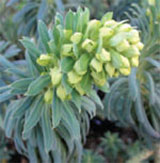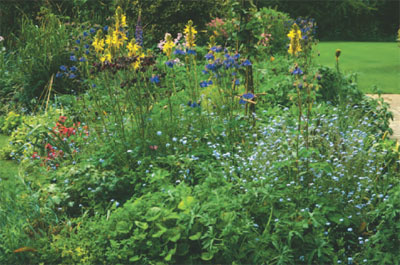Plant form in design
Content
The dominant plant within a garden feature is usually a tree or shrub chosen for its special striking appearance, or specimen plant. In a large feature, it may be a Betula pendula (silver birch) tree growing up to 20 m in height with a graceful form, striking white bark, and golden autumn colour. In a smaller feature, Euphorbia characias provides a very special effect with its 1 m high evergreen foliage, and springtime yellow blooms. Such plants can form a focal point in a garden or landscape. Spaced around these specimen plants, there may be included species providing a visually supportive background or skeletal form to the decorative feature. Garrya elliptica, a 4 m shrub with elliptical, wavy edged evergreen leaves and mid-winter catkins fits naturally into this category against a larger special plant. At 2.5 m, the evergreen shrub Choisya ternata (Mexican Orange Blossom) bearing fragrant white flowers in spring is a popular background species in decorative borders. Jasminum nudifolium (winter jasmine) is an example of a climber fulfilling this role. Such framework plants not only provide a suitable background, but also can provide continuity or unity through the garden or landscape and ensure interest all the year round. Fitting further into the mosaic of plantings are the numerous examples of decorative species, exhibiting particular aspects of general structure or of flowering, and often having a deciduous growth. An example is the 0.3 m tall Cytisus x kewensis (a broom with a prostrate habit) with its downy arching stems and profuse creamy-white spring flowers. A contrasting example is the 2 m clump-forming grass species, Cortaderia selloana, producing narrow leaves and feathery late summer flowering panicles. Climbing species from the Rosa and Clematis genera also fit into the decorative category. Garden designers are also able to call on a very wide range of leaf forms to create textural or architectural interest in the border. A host of deciduous pretty herbaceous and evergreen perennials are available for filling the decorative feature, fitting around the abovementioned three categories. Delphiniums (up to 2 m), Lupins up to 1.5 m), Asters (up to 1.5 m), Sedums (up to 0.5 m), and Alchemillas (up to 0.5 m) are five examples illustrating a range of heights. Finally, infill species either as bulbs (e.g. Tulipa, Narcissus or Lilium), perennials (e.g. Saxifraga, Campanula), or annuals (e.g. Nicotiana or Begonia), may be placed within the feature, sometimes for a relatively short period whilst other perennials are growing towards full-size. They are also used in colourful bedding displays. Colour in flowers
|
|||||||||||||||||||






